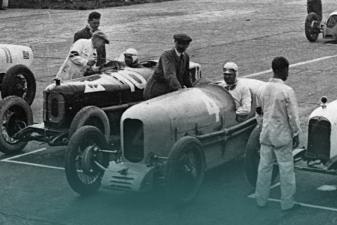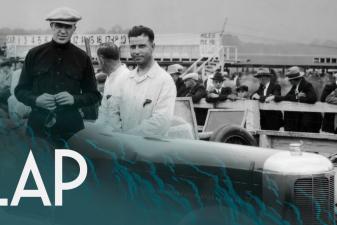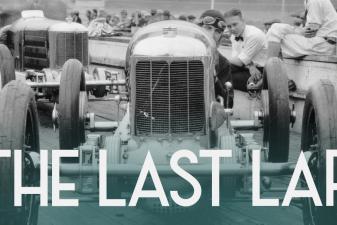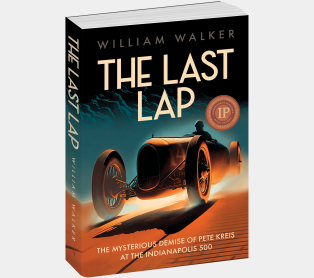The First Test of Pete Kreis

The following is an excerpt from The Last Lap by William Walker. In this excerpt, read about Pete's first test drive for the Duesenberg brothers—the commanders of the American racing scene in the early 1920s!
The Indianapolis Motor Speedway that the Kreises encountered when they arrived for Pete’s big test was one that was returning to good shape after some difficult years during World War I. The suspension of racing for the duration of the conflict meant that there was no money for upkeep, but when competition resumed in 1921, speed-hungry fans once again surged through the gate and brought funds needed for repairs.
The retaining walls, grandstands, and garages sported a new coat of white paint trimmed with the traditional green. Weeds and grass that had been creeping around the bricks were killed with a spray of gasoline. Although it was several months before the big day, workmen’s saws and hammers resounded all the way around the two-and-one-half-mile oval.
Fred and Augie had already been preparing the car for its run, and they spent several minutes with Pete going over instructions for the test. The brothers insisted that he drive five laps at low speed before working his way up to a high-speed run of ten laps and told him to keep the tachometer well below its 8500-rpm red line. With that, Pete gingerly climbed into the cockpit and guided the car onto the track to fulfill his dream.
Young Kreis was already familiar with the basic layout of the circuit. As teenagers, he and a friend had saved enough money to travel to Indianapolis to witness the 500, and Pete recalled the distinctive 2.5-mile rectangular oval.
The front and back straightaways were each some 0.625 miles in length, connected by two short chutes 0.125 miles long and four turns, each 0.25 miles in length. The straightaways were flat, and fifty feet in width, while the turns were banked at slightly more than nine degrees. To accommodate the banking, the curves were sixty feet wide.
The start/finish line where the Duesenberg brothers and John Kreis stood was three-quarters of the way down the front straight, some 150 feet before Turn One. The turns were named in numerical sequence and for proximate compass points: Turn One was the southwest curve; Turn Two, southeast; Turn Three, northeast; and Turn Four, northwest. The short straightaways were called the South Chute and North Chute.
Pete had never driven a purpose-built race car, and he had never been on a hard-surfaced, banked oval. He gratefully spent the five-lap preparation learning as much as he could about how to set up for the four corners, to control the car’s drift up toward the wall of the chutes, and to guide the machine to ideal apexes in the corners that would enable him to accelerate powerfully as he emerged onto the back and front straights.
Just like every other driver at the Speedway, Pete quickly realized that the corner that demanded the most attention was Turn One. From the vantage point of the start/finish line in the front stretch the corner looked wide and inviting, but as the car drew near the turn, the opening appeared to grow smaller and then completely disappeared into something resembling a dense wall. Perhaps it was the barrier of the retaining wall appearing to block the way, but driving through the first turn at speed was a maneuver that required the utmost concentration, precision, and courage. Already that corner had the reputation of causing more accidents and claiming more lives than any other turn at the Speedway, a fact that every racing fan—including Pete—knew.
In some ways, Turn One with its shadows, its dark background, and its diving left-hand move resembled the curve on Brabson Ferry Road where Pete had lost control of the Marmon. Although such associations were difficult to confront, the young Kreis overcame the menacing similarities as he always did: by challenging the situation head-on, as his father had taught. As he got more comfortable during the warm-up laps, he began to increase his speed slightly on entering the turn, and the graceful Duesey rewarded him by hanging deftly on the fast line as Pete cleared the short chute.
The five-lap warm-up was over, and Pete waved at the watching party as he drove over the starting line to begin the trial. As the Duesenberg brothers punched their stopwatches, Pete hit the accelerator to bring the car up to speed for the test. The 122-cubic-inch straight-eight hummed as Pete took the tachometer toward the redline and plowed into the first turn. The centrifugal force pulling the car toward the outer wall was more pronounced than he had calculated, but he only backed off a few hundred rpms to negotiate the turn. He sailed cleanly through the short chute and then hit the accelerator again on exiting the second curve.
Knowing that he had overcome the biggest hurdle gave Pete the confidence he needed. He decided that driving at Indy was not all that different from skidding around the dirt tracks of East Tennessee. So, he forged on following the concepts of racing that he had learned through the seat of his pants. Perhaps racing writer Sonny Kleinfield described it best: “The basic idea is to go so wickedly fast that the car barely stays on the road and comes as close as possible to skating off into the wall without actually doing so. The man who gets around the fastest is the man who drives closest to the brink of disaster.”
History does not record the lap times that appeared on the Duesenbergs’ stopwatches, but whatever they were had more than satisfied the brothers. They pounded Pete on the back as he climbed from the cockpit. The proud father—John Kreis—stood back to let his son soak up the adulation, but he did wear an “I-told-you-so” grin on his face the rest of the day. The young man’s achievement was a bit like a sandlot baseball player from the Smoky Mountains being named to the New York Yankees’ starting lineup after a single try-out on the diamond.
Pete became an official member of the Duesenberg team, which Fred and Augie treated as their extended clan. In addition to being named to the first family of racing, Kreis soon met the man who was to become his driving mentor and close friend—a young fellow of Italian descent, Peter De Paolo. With his round face, gap-toothed smile, and slender build, De Paolo had entered the racing business almost at birth, as the nephew of one of America’s first racing legends, Ralph De Palma, the winner of the 1915 Indy 500.
Check out the related books linked below for more of The Last Lap!






